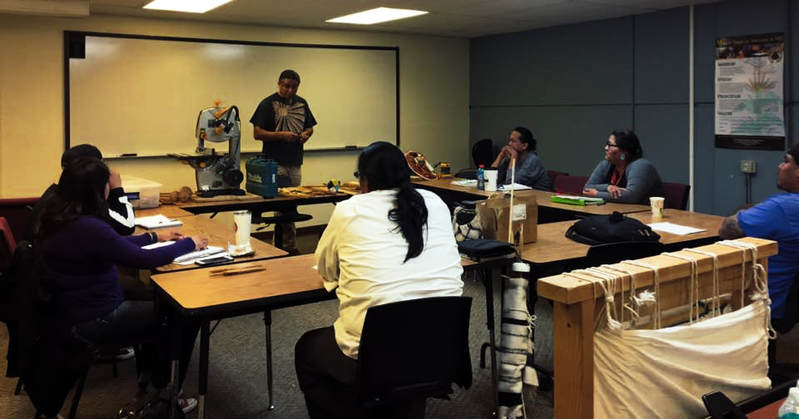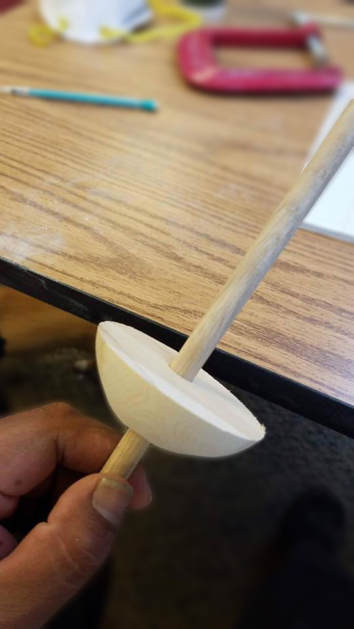|
A Posting by Zefren Anderson, Emerging Artisan Hello! I’m Zefren Anderson from the 2017-2018 Navajo Cultural Arts Program (NCAP) cohort at Diné College. I’m a weaver and this year I am emphasizing not only in my own craft of weaving but also in sliversmithing. As part of our Materials and Resource class, Mark Deschinny of Church Rock came to Tsaile to teach us how to make weaving tools. With the prowess and mobility of an olden days Honaghaahnii trader, Mr. Deschinny is a weaving toolmaker to the People of the southwest (more at www.geocities.ws/deschinny/Looms_and_Supplies). Although we were off to a late start, I maintained an open mind – wondering if Mr. Deshchinny’s teachings would coincide with, be contrary to or be entirely new to my own. All teachings are valid to the clans that hold them, and it’s an interesting exchange of ideas when clans share teachings. I have been taught within the family traditions of the Hashtlishniis - if it works use it, if broke, fix it and if it can’t be used, repurpose and reuse. Many of our family tools are remnants of bigger whole tools. For example, old split battens finding new life as needles, sticks and finishing tools. I’ve found that many clans don’t do this, so I’ve not had much success making tools for weavers when they asked how they were made. The same goes for the many stories of the oral traditions of each clan along with the anthropological knowledge of the tool use, design and origin. In my own research of recreating pre 1868 Navajo Weavings, I’ve come to find the stories and museums were the best places to learn how to create the tools. They are different from the tools we use today, but they are they are both part of a long story of living and surviving. Mr. Deschinny arrived with tools and goals. Two big totes full of various woods, examples pieces, and a few power tools created a complete woodshop for our cohort. The goals were simple: Comb (Bee’adzoo’i), Batten (Bee’K’initl’ish) Spindle (Bee’adizi). We shared personal introductions and he let us in on the story of how he came to support his family from tool making. He also shared that his family’s history included the creation of a comprehensive dye chart for education. His family takes great care in tool making, using local sustainable wood, natural finishes, and a philosophy to avoid abuse of our natural resources like wood. Use of fire and darkening of the grain is prohibited. After some safety training, we set off to create our projects. Bee’adzoo’í can be made from gamble oak or in our case juniper. In the olden days, a whole branch is carved and sanded until it resembles a five fingered Bee’adzoo’í. But now we can use a saw to create multiple combs from one branch. Most modern Bee’adzoo’í are prized for evenness, aesthetic beauty and even the heaviness that creates tight hard weavings prized by collectors all over the world. I created my comb in the manner of my Shinaliadzaanbima. The comb manipulates the weft texture first then, it sets lightly into the warps. It is cut out exactly in the manner of one’s hand with their fingers outstretched set ¾” into the wood. The tips expose warp and keep weft tight. The area near the joints of the comb will stretch the weft and hide warp and a rounded pick at the opposite end of the comb. Why do we care so much about the weft? …. In the old story of the 1st weaving a problem arose on the weft spacing and warp due to tension irregularities created by changes in humidity. It allowed weaving resume outside a regular source of water and the weaver could adapt technique to the environment. Bee’K’initl’ish can be made from any hardwood. For our workshop we used Red oak. Steaming or wet earth bending can create the characteristic bend of a stable batten, Mr. Deshchinny uses weight as the wood cures. Tips are usually sanded up as the weavers prefer this shape. A state of mind and manual finesse coupled with a belt sander will produce great results for Bee’K’initl’ish. During this step, the NCAP Cohort members sanded and shaped their combs. Not surprising…their created tools showed the particular personalities of their creators. The finally sanding took the longest as we went from tool to tool, queuing on the saw and sanders while sharing stories and teachings. The Bee’K’initl’ish was created after all the tools required to warp up a weaving, is was found using for quick weaving in solid colors, passing long bundles of string between the wraps but when the humidity went down the batten would leave uneven spaces in the weaving as the air dried. Another tool needed to be made Bee’adizi can be made from anything culturally appropriate -clay, metal, wood or even concrete. In class, pieces were cut from a spilt juniper branch so everyone had enough time to complete one. Bee’adizi has changed over the last few years, as even more weavers are less dependent on Navajo Churro and Wool and more on brown sheep Company wool. Now weavers have one spindle where in the past there were several each suited to a particular task or fiber, even in the oral stories there are 5 spindles working yucca, cedar, cotton and wool. I wanted a general-purpose abalone spindle for a pre 1840s Biiheeh project. It needed to be light, fast, short and balanced manually. Using the curve of the spilt branch as a guide I shaped the whorl while Mr. Deshchinny leveled and drilled the hole. By the end of class I had a perfect spindle for my future projects and I’m grateful for this whole day experience. I’m sure most of the NCAP cohort members also enjoyed themselves and got more from workshop than what they expected. I’m looking forward to the next workshop -- Traditional Dye and spinning.
0 Comments
Leave a Reply. |
Categories
All
Archives
October 2021
|
SocialsALL PHOTOS IMAGES ARE COPYRIGHT PROTECTED. PHOTO IMAGES USE IS SUBJECT TO PERMISSION BY THE NAVAJO CULTURAL ARTS PROGRAM. NO FORM OF REPRODUCTION IS PERMITTED WITHOUT WRITTEN PERMISSION FROM THE NAVAJO CULTURAL ARTS PROGRAM. |
Featured Pages |




